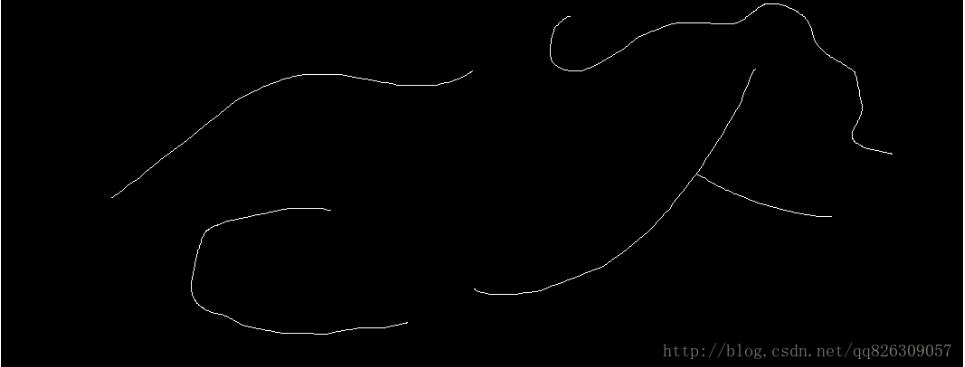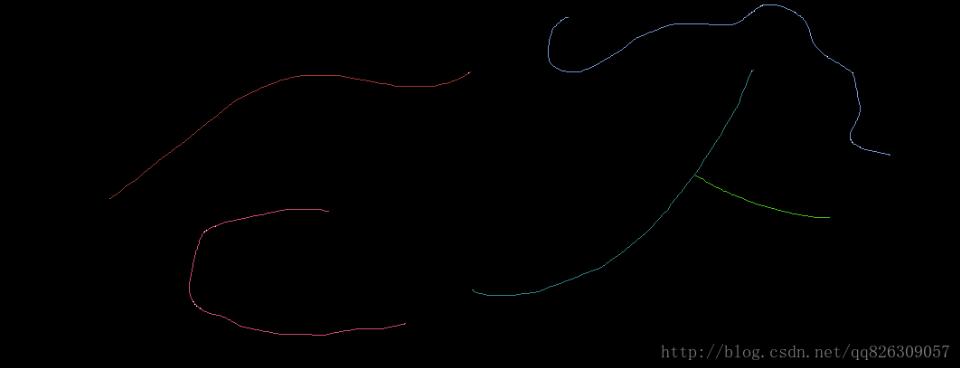您好,登錄后才能下訂單哦!
您好,登錄后才能下訂單哦!
這篇文章主要介紹OpenCV怎樣提取圖片中曲線,文中介紹的非常詳細,具有一定的參考價值,感興趣的小伙伴們一定要看完!
簡單介紹
??在實際的應用中,我們常常需要對圖像中的曲線進行描述、處理,這個曲線可以是輪廓,骨架或者其他。可以用deque<Point> 描述曲線,接下來簡單介紹下如何從圖片中搜索這些曲線并保存。
??首先,輸入的圖片是一張二值圖片 (白色為曲線),其中包含的曲線寬度為 1 像素的 (如果曲線不是 1 像素的 先提取其骨架)。遍歷尋找圖像中第一個白色的點,然后從這個點開始延伸尋找曲線。注意,第一個找到的點不一定是曲線的端點,因此應該分別向兩邊尋找相鄰的點,因此deque 會好一些。每找到一個點,將其保存deque 而后置黑(防止重復尋找)。搜索到一個沒有相鄰點的點,表示一端搜索完成。
?? 值得注意的一點是,我在寫搜尋相鄰點的時候,會首先搜尋此點與上一個點相鄰位置相對的位置,如果沒有,則分別搜索向兩邊搜索。這樣的好處是可以減少尋找的次數,而且當有相交的曲線時,能連接到我們一般認為的曲線。
代碼
//尋找圖像曲線上某個點的下一個點
bool findNextPoint(vector<Point> &_neighbor_points, Mat &_image, Point _inpoint, int flag, Point& _outpoint, int &_outflag)
{
int i = flag;
int count = 1;
bool success = false;
while (count <= 7)
{
Point tmppoint = _inpoint + _neighbor_points[i];
if (tmppoint.x > 0 && tmppoint.y > 0 && tmppoint.x < _image.cols&&tmppoint.y < _image.rows)
{
if (_image.at<uchar>(tmppoint) == 255)
{
_outpoint = tmppoint;
_outflag = i;
success = true;
_image.at<uchar>(tmppoint) = 0;
break;
}
}
if (count % 2)
{
i += count;
if (i > 7)
{
i -= 8;
}
}
else
{
i += -count;
if (i < 0)
{
i += 8;
}
}
count++;
}
return success;
}
//尋找圖像上的第一個點
bool findFirstPoint(Mat &_inputimg, Point &_outputpoint)
{
bool success = false;
for (int i = 0; i < _inputimg.rows; i++)
{
uchar* data = _inputimg.ptr<uchar>(i);
for (int j = 0; j < _inputimg.cols; j++)
{
if (data[j] == 255)
{
success = true;
_outputpoint.x = j;
_outputpoint.y = i;
data[j] = 0;
break;
}
}
if (success)
break;
}
return success;
}
//尋找曲線
void findLines(Mat &_inputimg, vector<deque<Point>> &_outputlines)
{
vector<Point> neighbor_points = { Point(-1,-1),Point(0,-1),Point(1,-1),Point(1,0),Point(1,1),Point(0,1),Point(-1,1),Point(-1,0) };
Point first_point;
while (findFirstPoint(_inputimg, first_point))
{
deque<Point> line;
line.push_back(first_point);
//由于第一個點不一定是線段的起始位置,雙向找
Point this_point = first_point;
int this_flag = 0;
Point next_point;
int next_flag;
while (findNextPoint(neighbor_points, _inputimg, this_point, this_flag, next_point, next_flag))
{
line.push_back(next_point);
this_point = next_point;
this_flag = next_flag;
}
//找另一邊
this_point = first_point;
this_flag = 0;
//cout << "flag:" << this_flag << endl;
while (findNextPoint(neighbor_points, _inputimg, this_point, this_flag, next_point, next_flag))
{
line.push_front(next_point);
this_point = next_point;
this_flag = next_flag;
}
if (line.size() > 10)
{
_outputlines.push_back(line);
}
}
}
//隨機取色 用于畫線的時候
Scalar random_color(RNG& _rng)
{
int icolor = (unsigned)_rng;
return Scalar(icolor & 0xFF, (icolor >> 8) & 0xFF, (icolor >> 16) & 0xFF);
}
int main()
{
Mat image = imread("images\\2.bmp");
Mat gray;
cvtColor(image, gray, CV_BGR2GRAY);
vector<deque<Point>> lines;
findLines(gray, lines);
cout << lines.size() << endl;
//draw lines
Mat draw_img = image.clone();
RNG rng(123);
Scalar color;
for (int i = 0; i < lines.size(); i++)
{
color = random_color(rng);
for (int j = 0; j < lines[i].size(); j++)
{
draw_img.at<Vec3b>(lines[i][j]) = Vec3b(color[0], color[1], color[2]);
}
}
imshow("draw_img", draw_img);
imwrite("images\\draw_img.bmp", draw_img);
waitKey(0);
system("pause");
return 0;
}結果
輸入圖像

結果

以上是“OpenCV怎樣提取圖片中曲線”這篇文章的所有內容,感謝各位的閱讀!希望分享的內容對大家有幫助,更多相關知識,歡迎關注億速云行業資訊頻道!
免責聲明:本站發布的內容(圖片、視頻和文字)以原創、轉載和分享為主,文章觀點不代表本網站立場,如果涉及侵權請聯系站長郵箱:is@yisu.com進行舉報,并提供相關證據,一經查實,將立刻刪除涉嫌侵權內容。